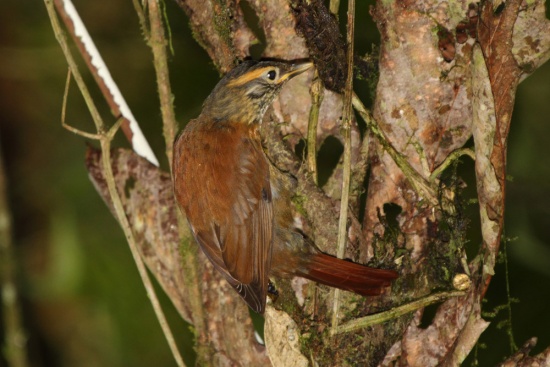- Anabacerthia variegaticeps
Identification
15–16 cm (6-6¼ in). Fairly typical brown foliage-gleaner with characteristic black and orangy face pattern.
- crown, most of face and malar streak dark, blackish
- eye ring and distal supercilium "spectacles" long (to neck) strongly orangey
- auricular area may include vague pale patch
- throat area paler, yellowish, more or less lightly streaked. May extend rearwards as a half collar.
- chest with coarse pale streaking (subspecies dependent)
- mantle and wings mid-brown
- primary coverts and distal part of primaries darker
- underparts often paler, light brown but may be quite dark orange (subspecies dependent)
- tail rufous
- bill wedge-shaped, greyish to cream
- eye dark
- legs dull greyish to yellowish
Distribution
Three well separated populations:
Central America: Mexico, Belize, Guatemala, El Salvador, Honduras, and northern Nicaragua; secondly from Costa Rica to western Panama
South America: west of the Andes in Colombia and Ecuador
Taxonomy
More than one species may be involved.
Subspecies
Clements recognises the following subspecies [1]:
- A. v. variegaticeps: South Mexico (Guerrero and Veracruz) to western Panama. [often pale beneath with chest streaking muted or absent. Greater tendency to have a "collar"]
- A. v. temporalis: West slope of Western Andes of Colombia and Ecuador. [dark underneath, more strongly orange with strong chest streaking]
Other authors recognise subspecies schaldachi of south-west Mexico (e.g. refs [2], [3])
Habitat
Montane and lowland evergreen forests. Also tall second growth forests.
Behaviour
Diet
They eat a variety of insects, including moths and spiders.
Breeding
They are thought to be monogamous. Their clutch contains 2 eggs, which are laid at the bottom of an old woodpecker nest hole.
References
- Clements, J. F., T. S. Schulenberg, M. J. Iliff, T. A. Fredericks, J. A. Gerbracht, D. Lepage, S. M. Billerman, B. L. Sullivan, and C. L. Wood. 2022. The eBird/Clements checklist of Birds of the World: v2022. Downloaded from https://www.birds.cornell.edu/clementschecklist/download/
- Angehr and Dean 2010: The Birds of Panama, a field guide
- Fagan and Komar, Peterson field guide to birds of northern Central America
- Gill, F, D Donsker, and P Rasmussen (Eds). 2023. IOC World Bird List (v 13.2). Doi 10.14344/IOC.ML.13.2. http://www.worldbirdnames.org/
- HBW and BirdLife International (2022) Handbook of the Birds of the World and BirdLife International digital checklist of the birds of the world. Version 7. Available at: http://datazone.birdlife.org/userfiles/file/Species/Taxonomy/HBW-BirdLife_Checklist_v7_Dec22.zip
Recommended Citation
- BirdForum Opus contributors. (2025) Scaly-throated Foliage-gleaner. In: BirdForum, the forum for wild birds and birding. Retrieved 9 May 2025 from https://www.birdforum.net/opus/Scaly-throated_Foliage-gleaner
External Links
GSearch checked for 2020 platform.1




